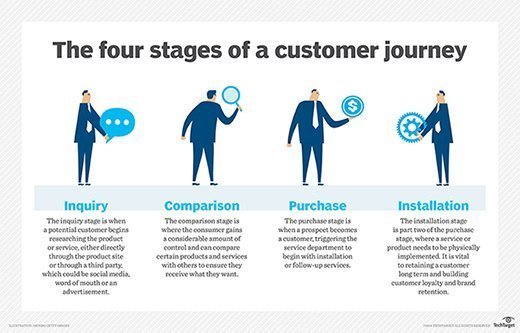Customer acquisition cost (CAC): How to calculate and reduce it
Customer acquisition cost (CAC) is the cost associated with convincing a consumer to buy your product or service, including research, marketing and advertising costs. Basically, it is the total cost incurred and the resources expended by the company to acquire a new customer.
An important business metric, the cost of customer acquisition should be considered along with other data, especially the customer's value to the company and the resulting ROI of acquisition.
Calculating customer lifetime value (CLV) helps a company determine how much revenue a particular account (customer) will bring in over its lifetime. Together, CAC and CLV enable firms to measure the value generated by a new customer and, accordingly, implement strategies to gain and retain high-value customers.
How to calculate customer acquisition cost
Customer acquisition cost is a numerical value calculated using a mathematical formula. Two such formulas are available: a simple formula and a complex formula.
The first step in calculating CAC is to determine the reporting period. Businesses typically calculate customer acquisition cost monthly, quarterly or annually.
However, firms with long sales cycles can calculate CAC over a longer period. For example, a business with an 18-month sales cycle can calculate CAC over a two-year horizon. If it takes the company an average of 18 months to close a sale, then the sales and marketing expenses incurred this month -- and possibly this quarter and this year -- will not influence a sale until later. Using a longer time period ensures that sales and marketing expenses are correctly associated with the customers acquired in that period.
After determining the reporting period, the next step is to calculate the total sales and marketing spend for that period.
The final step is to note the number of customers acquired in that period.
These three steps are sufficient to calculate CAC using the simple formula.
Simple formula for CAC
The simplest formula for calculating CAC is the following:
CAC = Sum total of all sales and marketing expenses
Number of customers acquired
The values in the numerator and denominator must use the same reporting period.
For example, if the total monthly sales and marketing expenses are $15,000 and a business acquires 150 customers in the same month, the customer acquisition cost is $100.
This method provides an easy way to calculate CAC since it doesn't consider the costs of other parameters like software, external consultants, overhead, etc. Ignoring these parameters can skew the CAC and result in unsound decision-making regarding marketing strategies and investments.
Complex formula for CAC
A complex formula for calculating CAC accounts for additional expenses plus total sales and marketing expenses.
To calculate CAC using this formula, these additional parameters are considered:
SMS: Sum total of all sales and marketing expenses
W: Marketing and sales wages/salaries
S: Cost of sales and marketing software
PS: Cost of any additional professional services used in sales and/or marketing
O: Total overheads
CA: Number of customers acquired in a specific period
The complex formula can be stated as follows:
CAC = SMS + W + S + PS + O
CA
Continuing the previous example, SMS remains $15,000, and CA remains 150. The additional costs are as follows:
W = $5,000
S = $500
PS: $1,500
O: $3,000
Now, the CAC can be calculated as:
CAC = 15,000 + 5,000 + 500 + 1,500 + 3,000 = $167
150
Formula 2 is more complex than Formula 1. However, it also yields a more accurate CAC calculation. The difference in the CAC calculated with the two formulas can be significant for high-value products and customers. Relying on the less accurate number can adversely affect decision-making.
In addition to the two formulas above, another CAC formula is also available. Known as Paid CAC, it only considers the total marketing and sales spend and the number of customers gained through paid channels (CAP).
It can be expressed as:
CAC = SMS + W + S + PS + O
CA
This calculation enables marketing teams to plan ways to reduce SMS and optimize ad spend in order to increase CAP.
What does customer acquisition cost include?
When calculated using the complex (and more granular and accurate) formula, customer acquisition cost includes the sum total of all sales and marketing expenses incurred to acquire a customer. These costs include the following:
- Salaries. The wages paid to sales and marketing personnel;
- Cost of equipment. Any equipment used by sales and marketing personnel, such as computers, phones and printers, should be accounted for in the CAC calculation.
- Software. The cost of all applications used by the sales and marketing teams, such as customer relationship management (CRM) platforms and marketing automation tools, should be included in the CAC formula;
- Professional services. Any third-party consultants and agencies used for marketing, advertising or creative needs are part of CAC;
- Advertising spend. The total advertising cost incurred, including the cost of online ads, direct mail, television advertising, out-of-home advertising, and event and conference sponsorships; and
- Price discounting. If a product's list price is discounted to attract and acquire a customer, the discount amount is added to the customer acquisition cost.
Some businesses may incur additional sales and marketing expenses not listed above. All sales and marketing expenses must be added to the numerator to calculate customer acquisition cost accurately. Omitting sales and marketing expenses, whether intentional or accidental, leads to an inaccurate CAC number that may be artificially favorable to the company and therefore not show the true cost of acquiring that customer.
Why is calculating customer acquisition cost important?
Calculating the customer acquisition cost is important to businesses for several reasons:
- Improve ROI. A clear CAC number is essential to calculate and analyze marketing ROI. How many customers did the company gain by sponsoring social events? How many were gained through paid social media ads? And how many through TV advertising? By calculating the CAC for each of these channels, firms can determine which channel is yielding the most bang for their buck. They can then focus their efforts and money on utilizing the most cost-effective channels to acquire customers.
- Optimize the sales and marketing budget. By reviewing the CAC, decision-makers can determine whether they have allocated enough budget for sales and marketing activities. If a particular activity is more effective at acquiring customers, they can allocate a bigger budget to it and reduce the budget allocated to less effective activities.
- Improve profitability. A lower CAC means the company spends less money to acquire a new customer. By identifying and leveraging cost-effective acquisition strategies, companies can keep the CAC low and increase profit margins and profitability. Another way to boost profitability is to compare CAC with customer lifetime value. Suppose the CAC is much higher than the CLV (a 3:1 CLV CAC ratio is a healthy benchmark to follow). In that case, it indicates excessive spending on customer acquisition that may adversely affect the bottom line.
- Financial planning. Businesses can calculate a CAC payback period to assess their financial health and plan future strategies. The CAC payback period is calculated by dividing the CAC per customer by the monthly revenue generated per customer. This period shows how long it will take for the firm to break even and start earning a profit from each new customer. If the period is too high (undesirable), acquisition strategies or the product price may need to be adjusted.

How to reduce customer acquisition cost
If the CAC is too high, particularly concerning the CLV, it can negatively affect the organization's profitability. This is why it's important to reduce the CAC. Some strategies to reduce the CAC include the following:
- Create customer segments. To maximize CLV and reduce CAC, it's crucial to sell the product or service to the right customers. These are the customers with specific pain points or needs that can be satisfied by the firm's offerings. Customer segmentation can help organizations to identify the right audience and focus their sales and marketing efforts on them. Additionally, creating buyer personas and an ideal customer profile can help prevent the allocation of sales/marketing budgets to ineffective channels.
- Don't rely only on paid channels. Paid channels can be effective but also expensive. Reliance on paid channels increases the CAC. Stopping payments doesn't help reduce CAC if the organization has not invested time and effort in acquiring customers through alternate, organic channels. Organic channels like SEO and content marketing may not generate results as fast as paid channels; however, they can bring in more customers over time, leading to consistent and sustainable CAC reduction.
- Deliver positive customer experiences. In general, acquiring a new customer costs more than retaining an existing customer. By providing a quality product, personalized experience and excellent support, companies can optimize the customer journey and increase CLV. Also, asking for feedback fosters trust in the brand and keeps existing customers returning. The better the customer retention, the more the customer base grows, and the lower the CAC will be.
- Use marketing automation. Marketing automation platforms can perform many tasks that would otherwise require expensive human resources. The software can lower resource costs and aid in optimizing marketing expenses, which eventually positively affects the CAC.
- Optimize conversion rates on your website. Conversion rate optimization (CRO) includes practices to maximize value from traffic to the company website. For example, clear calls to action guide visitors on what action to take, such as a purchase or sign-up. This can boost conversions and reduce CAC. Other CRO practices that can bring CAC down include improving site loading speed, page layout, displaying testimonials and customer reviews, optimizing the site for mobile and improving site accessibility for differently abled users.
Examples of customer acquisition cost
Here are a couple of examples of customer acquisition costs in the real world:
Example 1: How to achieve a favorable CAC using simple means.
Let's consider a fictional company, Creatif, Inc., that makes car stickers and decals.
One of their popular bumper stickers includes a link to the company's online store. The sticker's popularity means it grabs more eyeballs, leading to more website visits and, ultimately, more purchases.
Creatif, Inc. does not employ sales and marketing personnel. The only costs associated with acquiring new customers are the website's design, hosting and e-commerce transaction fees. This example shows that large teams and fancy marketing strategies are not always required to lower CAC; sometimes, simple word-of-mouth marketing or buzz marketing can be equally or more effective.
Example 2: How to reduce an unfavorable CAC.
Now let's consider Novo Ltd., which sells ERP solutions to medium and large businesses.
Suppose Novo Ltd spends $8,000 to acquire a new customer. However, the customer's CLV is only about $2,000. Basically, the company spends 4X as much on acquiring the customer as the value that the customer will bring to the company in return. This 4:1 ratio pulls down profitability, so Novo Ltd. must look at strategies to optimize marketing spend. They can do this by creating customer segments, marketing through organic channels, delivering positive customer experiences and optimizing website conversions.
Learn about different customer segmentation methods to help organizations identify their customers better. Also, customer experience plays a part in retaining customers and driving revenue and profit. Master the top 10 customer success key performance indicators and metrics you should track.






